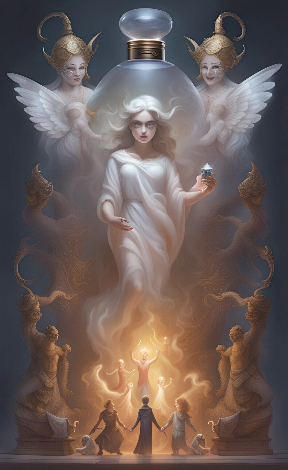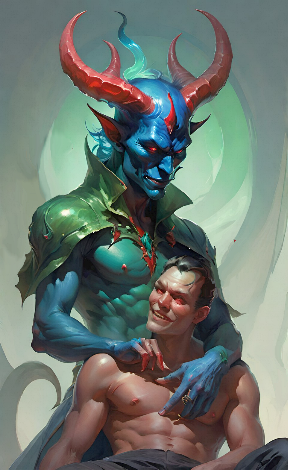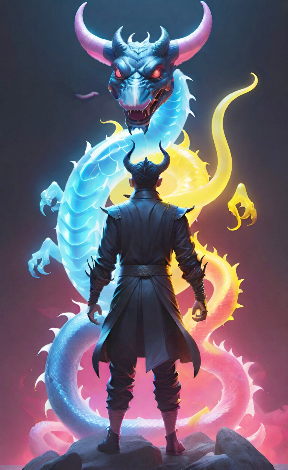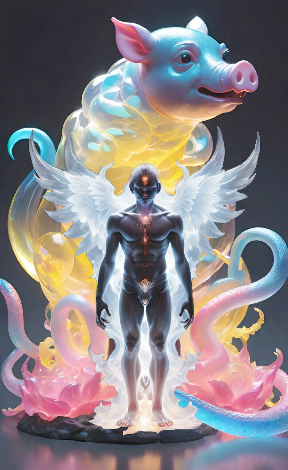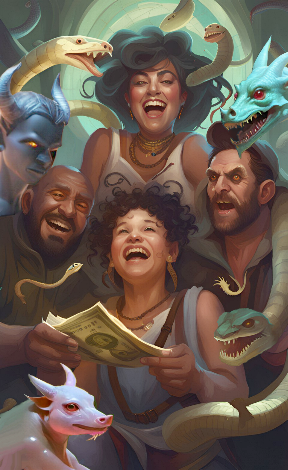The Struggle of the Subtle Three and the Subtle Seven for Man
Feelings in which you were offended,
are never the best.
Enemies
When discussing human interactions, one must not forget the figure of the rival or personal enemy. Sometimes, it is the enemy who becomes the first person on whom one fixes their gaze, which until that moment was focused exclusively on oneself. You're sitting quietly in a sandbox, making sandcakes and castles, and then suddenly someone appears, takes your shovel, and hits you over the head with it—how can you not become deeply interested in the aggressor's personality?
The first appearance of an enemy or rival is most often a way to shift a person's attention to something sharply different from themselves, which is accompanied by a significant jump in the assembly point, always into an area that is quite stressful for the person, where they lose control over the situation. The unpleasantness largely lies in the fact that a person is highly dependent on their enemy (rival)—either directly or indirectly, but, nevertheless, quite significantly for themselves. This situation of unpleasant interdependence is most often due to the fact that the person and their rival have something to share: a beloved woman, a place under the sun, fame, and the like. From the perspective of inner life, the appearance of a rival means the activation of a certain lower subconscious program that loudly asserts its rights. Simultaneously, in the subtle world, a certain entity actualizes and begins to wage war with the person.
This war can look different. Sometimes, in the outer world, a rival appears whose Dragon constantly asserts itself by humiliating the person's personal Dragon. Sometimes, it's an offender whose Black One suppresses, say, our hero's Black One, Dragon, and Pig. It can even be simply someone else's Pig that brazenly eats away at a person's personal Pig, and that turns out to be very difficult to endure. There are also more complex situations where the Yellow One or the Serpent or several subtle figures at once are active. However, on the external plane, the problem of relationships with an enemy or rival can only be resolved after the person deals with the behavior of their own Subtle Seven and understands why it reacts so painfully to the enemy's behavior. In general, it's best to view the enemy as your distorted mirror, in which your current shortcomings and imperfections are most prominently reflected.
However, one should not underestimate their enemies. The Karmic Egregore always presents a person with tasks that they can only solve by gathering all their strength and skills, and even then not immediately, but after considerable effort. In particular, by learning to cope with their Subtle Seven, a person gets rid of crude enemies and primitive rivals, but does not fundamentally solve this problem. However, even at the level of fighting, for example, Draconian enemies (i.e., partners who assert themselves at a person's expense), there is often a known repetition of plots, which leads one to suspect the presence of a subtle entity, more subtle than the personal Seven, which constantly creates certain intrigues against the person, literally putting partners-enemies with a large Dragon in their path, immediately engaging in battle with the person's own personal Dragon. At the same time, it may well turn out that the person, on the second such occasion, has, as they say, "understood everything" and curtailed their personal Dragon, but the plot, nevertheless, does not think of ending. What is the matter here?
Each person is accompanied throughout their life by three subtle entities (significantly subtler than the Subtle Seven), which are messengers of the three Main Egregore. These entities correspond to much deeper subconscious programs than the Subtle Seven's vanity, egoism, and so on, and a person usually barely notices them, or sees their manifestations indirectly. The first Egregore of Will sends a person a subtle entity, which is hereinafter referred to as the Personal Demon. In the inner world, it corresponds to the figure of the Inner Enemy. The second Egregore of Perception is related to the Loving Soul. The third Egregore of Action sends a person an Informing Angel, helping them in the direct informational connection with the karmic egregore. A person who has largely resolved internal problems with their own Subtle Seven reaches the level of direct interaction with the Personal Demon, Loving Soul and Informing Angel as partners. However, an ordinary person constantly interacts with them indirectly and from time to time enters into direct contact with them, although they may not realize it. These moments are very important: not only as preparation for future interaction, but also as an opportunity to see the central moments of one's own subtle karma (atmanic body).
Loving Soul
Every person has a soul of the opposite sex that loves them, but most often it is not embodied in anyone. Striving to express its love for a woman, her (male) Loving Soul finds a suitable man in space and instills in him love for this woman, aiming for him to express this love, including forms of expression and the most appropriate signs of attention, intimate caresses. The Loving Soul of a woman prompts the man in love with absolute precision: the woman gets the impression that her beloved has always known her. But for this, the man needs to listen not to female whims or even his personal intuition, but to a peculiar gentle extraneous being, flying to him with its love for this woman and precise knowledge of what she desires and needs. However, for adequate contact, the woman must also try to perceive behind the man that Loving Soul which seeks to convey something subtle but very important to her through the embodied man, something that she herself does not possess and cannot possess.
Therefore, the love that a person feels for different representatives of the opposite sex, is always different. Different Souls awaken it in him, and the feelings which he receives from others are always in some way the same — it is the love of one and the same Loving Soul — but receiving various embodiments, more precisely, various editions, through his various beloveds. But for that, in order to feel this, one needs to be attentive doubly and allow oneself both the perception and the formalization of the most unexpected and unfamiliar soulful and material impulses arising in the direction of the beloved being, who, it should be said, rarely knows what he wants, and even more rarely realizes what he needs.
Personal Demon
The Egregore of Will sends a person a Personal Demon for the external accentuation of their most current inner problem. Internally, the Inner Enemy performs the same function. It is very difficult for a person to rationally understand the logic of the Personal Demon, that is, to adequately model it in the mental body, since the Demon works with those subconscious programs that are practically inaccessible to human consciousness and most often cause a strong protest in them regarding personal fate: "Why the same thing for so long? Why so tormenting and why so meaningless?" — says the person, addressing the Almighty or the Lords of Karma (depending on their faith). However, He or They remain silent or say something incomprehensible, like "It must be so" or "You'll grow up, Sasha, and you'll know." And in a person, depending on the more or less harmonious circumstances of their fate, a clear impression is created that the Lords of Karma are terrible over-cautious beings or terrible bores, or (in the worst cases) — methodical sadists. These judgments, however, are completely unfair.
The fact is that sometimes the mission that a person must fulfill in their life does not require a radical restructuring of their psyche and the mastering of qualitatively new areas of the assembly point, and then they will, quite likely, live a life without ever feeling the icy breath of their Personal Demon's wings or even suspecting the existence of an Inner Enemy — and the public subconscious considers such destinies normal and, moreover, exemplary, categorizing all others (though the latter constitute the majority) as unhealthy or pathological.
However, as a rule, a person still faces the necessity of radically changing their opinion of themselves and their way of seeing themselves and the world, and here, small means often fail, although one strongly wishes they wouldn't. And then the Inner Enemy comes into play, which calls the Personal Demon. And the circumstances of external and internal life literally begin to drag the person's assembly point into a qualitatively new position for them, despite their desperate resistance. This is precisely where the idea of the Lords of Karma being bores or over-cautious arises. In reality, this is not the case at all. It simply means that much more is required of the person here than they think or desire. For example, Yellow One, often together with Gray One, shout: "You're fundamentally incapable of this, even if you twist yourself inside out." Thus, the Inner Enemy or, more culturally expressed, the Opponent, is, in theory, an unconditionally positive figure in a person's life, provided, of course, that one does not seriously fight with them — that's when things can truly go wrong. Similarly, the Personal Demon can manifest in a very unpleasant way for a person: for example, putting spokes in the wheels of their social advancement; or constantly providing partners for the same completely unsatisfactory relationship program (say, of the "love 'em and leave 'em" type). But fighting with it for one's happiness, especially as understood by society, is better avoided. Firstly, it's meaningless and will only make things worse, and secondly, karma means something else entirely: a strong shift in the assembly point. And until the person does this, the Demon will not leave them alone. In the most extreme case of stubborn resistance, heavy, irreversible losses begin, including illnesses and the death of loved ones and the person themselves, because the messenger of the Egregore of Will cannot be outwitted.
Informing Angel
And finally, the third entity sent to help a person by the Egregore of Action, is the Informing Angel. Its task is to help a person orient themselves in the flow of daily external and internal events, so that they better feel the will of their karmic egregore, including being able to tune into it at the right moment and receive its message, or, conversely, transmit information of interest to it. The Informing Angel acts both in the person's inner and outer world.
In the inner world, it manifests as a quiet, unobtrusive, and very laconic voice that comments on events. It is very easy to interrupt, and it never objects or insists on its point. But the person invariably becomes convinced of its fairness, although this voice most often answers nothing to the question "why?", meaning it does not convince of the correctness of its instructions and does not elaborate on them in any way. Its task is to convey essential information to the person, but not to convince them of its truthfulness.
In the outer world, the Informing Angel sends people, books, and other sources of important information to the person, and places emphasis on events in such a way that their subtle meaning and role in their life become clear to the person. A developed person knows how to read the signs of the Informing Angel in the most ordinary events of external life, which allows them to behave much more accurately and exert fewer senseless efforts. At a high level, a person sees the signs of other Informing Angels, that is, signs in the lives of other people, and therefore can say much about their subtle situations.
The Struggle of Subtle Figures for Human Influence
The three subtle entities described (the Subtle Three), guarding a person and leading them along the evolutionary path (whether they want to or not, whether they realize it or not) nevertheless encounter fierce resistance from GagtungrDemon Gagtungr includes and is responsible for a number of lower Demons: Histurg, Fokerm, and Urparp. Each of them possesses significant power.
Gagtungr has always ensured the widespread introduction into our solar system of the coarsely vibrating bacilli of Cosmic Evil, called the "ego-principle." From the gloomy astral centers of emanations of lies, theft, violence, and religious hypocrisy, he forms ideas that he then projects onto the physical plane, to enable the existence of all fallen and still imperfect consciousnesses (such as Non-humans)., who literally incites the Subtle Seven against them. And although this is not so simple, since the Subtle Seven exists on lower vibrations than the Subtle Three, nevertheless, the Seven initially manages to do a lot to distort the Three's influence. Some characteristic techniques (though not all) of this war are described below. However, the reader should always bear in mind the high origin of the Subtle Three. It can be viewed as three hypostases of the same entity. Perhaps the concept of a Guardian Angel is appropriate here, but not in its overly traditional understanding.
The main method of Gagtungr's struggle with the Subtle Three is to create an image of an enemy that is hung upon it. Or, in other words, the Subtle Three is accused of the Subtle Seven's sins, while the latter parasitizes on its information-energy flows. These techniques, however, only work as long as a person poorly distinguishes the vibration levels of information-energy flows.
The main struggle is waged within the Main Egregore, meaning the Dragon and the Black One fight the Personal Demon, the Pig, the Yellow One, and the Serpent go to the Loving Soul, and the Hurrier and the Gray One fight the Informing Angel, although cross-interactions are, of course, also possible.
Personal Demon vs. Dragon and Black One
Upon the appearance of the Personal Demon, which manifests as an external or internal impulse to significantly change the position of the assembly point, the Dragon instantly awakens and delivers, for example, the following speech: "Man—that sounds proud. And you are truly a microcosm, a Universe in miniature, as well as an immortal Spirit, always existing and incorruptible. All teachers, both high and worldly, are within you, so you have nothing to learn and no reason to, and even less should you react to the foolish provocations of external chaos or obvious inner enemies." In a less educated version, the Dragon simply says: "I know myself best, and you can all go to hell!" The main meaning of these speeches is to keep the assembly point in its initial state, and the more urgent a significant shift is for the person, the more active the Dragon becomes: "It's too late to change me! I'll die as I am!" — he concludes his accusing speech regarding the criminal acts of the Personal Demon.
The Black One assigns blame for all misfortunes that befall a person to the Personal Demon. Furthermore, it presents itself as the sole protector against the world's increasing aggressiveness. "Enemy forces are gathering around you," it threatens its host, "arm yourself before it's too late!" Indeed, a strong shift in the assembly point moves a person into a new reality for them, where old defense mechanisms cease to work. But this does not, generally speaking, mean that they will be defenseless there, and even less does it mean that one should immediately arm themselves to the teeth with familiar weapons. In fact, the Black One wants to turn this weapon to defend against the "aggressor" who forces the person to shift the assembly point. The result of the Black One's activity is often a person's view of their Personal Demon as a subtle and cunning archenemy, which is also reflected in a negative attitude towards the figure of the Inner Opponent, who is extremely useful to a person, serving as a kind of quality control department and preventing many future unpleasant surprises. At a low level, the Opponent is generally perceived as an enemy, and the Personal Demon is almost seen as a satanic figure (whence the name).
Loving Soul vs. Pig, Yellow One, and Serpent
Three entities wage war against the Loving Soul: the Pig, the Yellow One, and the Serpent.
As soon as a person experiences an extraordinary feeling in contact with another, denoted by any shade of the word "love" or something close to it, their Pig opens its mouth wide, exclaiming joyfully: "Finally, it's a holiday on my street too! Now I can finally fill myself up a bit after all these years of forced starvation!" The Pig doesn't even think of chasing away the Loving Soul; on the contrary, it welcomes it in every way, but subtly translating the person's assembly point into an area corresponding to the perception of energies more delicious for it. These are not necessarily sexual energies, although, of course, they attract the Pig tremendously. But even purely romantic infatuation, carried out in strict accordance with the clichés of fiction, completely blocks a person's perception of the emanations of the Loving Soul. And if it turns out that the partner is also focused on consumption, then the friendly pair of Pigs not only lowers the level of meditation but also quickly pollutes the subtle atmosphere of communication. The lovers begin, for reasons unclear to themselves, to quarrel over trifles, irritate each other, and so on. The difficulty also lies in the fact that to perceive the emanations of the Loving Soul, a corresponding alignment of both is needed, and the activity of at least one of their subtle figures in at least one of the partners becomes an insurmountable obstacle here.
The Yellow One can behave differently depending on the level of intimacy in communication. While contact has not arisen, it can sow doubt in the person's soul: "Can this person be trusted? You can't open your soul to just anyone"; or directly distort partners' perception of each other; arrange false situations, deceptions, mutual misunderstandings, and so on. If, despite its resistance, a high meditation still begins between partners, the Yellow One strives to lower it as much as possible and send the couple into the worlds of FokermaDemoness Fokerma is the world harlot, the mother and progenitor of all sexual perverts, prostitutes, and harlots. She skillfully wields the most powerful force on Earth - sexual energy. She tempts people to drag their fallen souls, unstable to such trials, into the rotten swamp of the Antiworld, transforming them for entire evolutionary cycles into obedient slaves of Gagtungr., and distort the words and feelings of the Loving Soul as if they came from there. At the same time, for the perception of the Loving Soul, a high level of trust and alignment of partners' assembly points is needed, and as soon as it is lost, it ceases to be heard. And when contact is disrupted, the Yellow One says to the person: "Well, there it is, not it again—let's go look further"—although one should learn to listen to what the high egregore tells you, and not look for a megaphone that makes it easier to hear (since He does not use amplifiers).
The Serpent will start by telling an appropriate anecdote about Romeo and Juliet or, armed with a guitar, singing a folk ditty that begins with the words: "My dear returned from the army." If this doesn't help and it's ignored, it can show the young man his beloved in a slightly parodied form, say, emphasizing her freckles: "What kind of high feeling can there be for a nose speckled in spring?" Its owner—of any gender—still cannot be taken seriously. The Serpent always strives to introduce into relationships a dose of humor or irony, destroying the meditation that is actually taking place. And the higher it is, the fewer means are required for this. An ill-timed sarcastic smile can break a contact that was established with great effort, and it will never be repeated, to the great joy of the Serpent.
Informing Angel vs. Hurrier and Gray One
With the Informing Angel are fought by the Hurrier and the Gray One.
The Hurrier demands, first, concreteness, and second, immediate application of the information received from the Informing Angel. Moreover, the Hurrier constantly forces a person to push their intuition, instead of patiently waiting for the instructions from the Informing Angel that come on their own, both in the external and internal worlds. Many signs of the Informing Angel are initially general in nature and are later refined as needed, and the Hurrier forces this process, disrupting the connection. Furthermore, a special language is usually used to establish this connection, which the Informing Angel offers halfway, and the person himself clarifies the other half, and this requires prolonged effort from the latter, initially yielding almost no results, and the Hurrier, as you understand, cannot tolerate this. At the same time, forcing one's clairvoyance, intuition, and the like leads to the loss of connection with the Informing Angel, and the corresponding channel is intercepted by UrparpDemon Urparp is the organizing principle of form in matter. He represents the lower consciousness of Gagtungr, responsible for form-creation and ensuring, through the elements of nature, the direct realization of Lucifer's goals and plans on Earth. In particular, it was Urparp who spawned the predatory principle in the animal kingdom - the law of mutual devouring. Urparp is the builder of intrigues, the avenger, the punisher., which may initially be perceived by the person even as an amplification of the channel, as audibility improves, but the nature of the information received, its reliability level, and its influence on the person quickly reveal its origin.
The Gray One quite quickly casts doubt on all information intuitively received by a person. External signs it most often attributes to superstitions, but sometimes it interprets them itself, naturally, as harbingers of inevitably impending troubles—what kind, it is not inclined to specify. What's the difference? Diseases, accidents, natural disasters, organized or unorganized crime—in any case, expect no good. It is clear that the Gray One completely denies the possibility of any specific prediction by a person of their (or someone else's) future, let alone constructive influence on it. At a higher level of connection with the Informing Angel, when it sends a person a clear informational flow, the Gray One will speak in such a vein, for example: "Here's more nonsense getting into his head, so he immediately puts it on paper. He should be ashamed of people, if he doesn't fear God! Half of what you write are well-known truisms, the rest is gross delusion, well, at least it's sincere."
In conclusion, the author suggests that the reader consider, as an exercise, the participation of the members of the Subtle Seven in specific roles that fall to a person in their life. The author himself limits himself to only a few characteristic examples (the leading members of the Subtle Seven are indicated after the roles).
Family Roles
Father — Dragon, Black One, Pig, Gray One.
Mother — Hurrier, Black One, Gray One.
Son — Serpent, Pig, Black One, Yellow One.
Daughter — Pig, Yellow One, Serpent, Black One.
Small child — Hurrier.
Grandmother — Yellow One, Gray One.
Grandfather — Gray One, Black One.
Daughter-in-law — Serpent, Yellow One, Black One.
Son-in-law — Black One, Serpent.
Social Roles
Senior Boss — Dragon.
Immediate Boss — Black One.
Distant Subordinate — Gray One, Yellow One.
Immediate Subordinate — Gray One, Serpent, Yellow One.
Official (e.g., maître d') — Dragon.
Customer — Gray One, Black One (in developed countries — Pig).
Seller — Black One, Dragon (scarce goods), (in developed countries — Serpent).
Worker — Gray One, Serpent (in capitalist countries — Hurrier, Black One).
Man in love — Black One, Serpent.
Woman in love — Pig.
Lover (male) — Serpent, Pig.
Lover (female) — Pig, Serpent.
Party Roles
Guest — Yellow One, Serpent, Dragon.
Host — Dragon, Yellow One, Serpent.
Beautiful woman — Dragon, Pig.
Unattractive woman — Black One, Gray One.
Sexpot woman — Serpent.
Handsome man — Dragon, Serpent.
Insecure man — Dragon, Pig.
Interesting man — Serpent.

